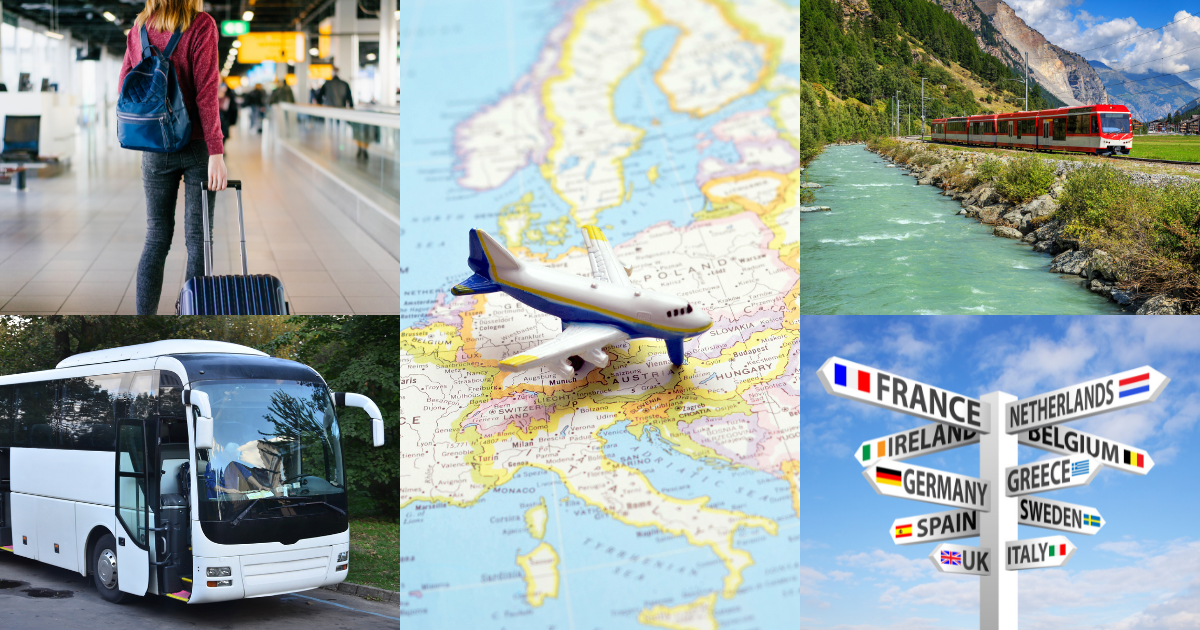In this article, we will explore the various modes of transportation available to travelers in Europe and discuss the convenience and accessibility of each option. I will also provide tips and advice on how to navigate different cities and countries efficiently.
By the end of this read, you will have a better understanding of the ease with which you can explore the diverse wonders of Europe.
Is It Easy To Get Around Europe?

When planning a trip to Europe, one of the most important considerations is how to get around once you arrive. With its diverse countries and cultures, navigating the transportation systems can seem daunting.
However, Europe offers a variety of convenient and efficient public transport options to help make your journey smooth and enjoyable.
In this article, we will explore the different modes of transportation in Europe, ticketing and fare options, navigating within and between cities, travel documents and visas, language barriers, cultural considerations, safety, and security, as well as accessibility for disabled travelers.
Public Transport Options
Europe boasts an extensive and well-connected public transportation network, making it easy for travelers to move between cities and countries. Depending on your preferred mode of travel, you can choose from trains, buses, and air travel to reach your desired destinations.
Train Travel

Trains are a popular choice for traveling around Europe, mainly due to their efficiency and comfort.
Europe is known for its high-speed train networks, such as the famous TGV in France and the Eurostar connecting London to Paris and Brussels.
These trains offer a quick and scenic way to travel between major cities, allowing you to sit back and admire the picturesque landscapes along the way.
Bus Travel
If you prefer a more budget-friendly option, buses are a convenient mode of transportation in Europe.
Many companies offer long-distance bus services, such as FlixBus and Eurolines, providing affordable and comfortable journeys between cities and countries. Bus travel also allows you to experience scenic routes while mingling with fellow travelers.
Air Travel
For longer distances or when time is of the essence, air travel is the quickest option. Europe is home to numerous international and regional airports, offering a wide range of flights to various destinations.
Low-cost airlines like Ryanair and EasyJet provide affordable options for intercity and intercountry travel. However, keep in mind that air travel often entails stricter baggage restrictions and longer check-in procedures compared to trains and buses.
Ticketing and Fares
When it comes to purchasing tickets and navigating fare systems in Europe, it is essential to familiarize yourself with the available options to ensure a hassle-free journey.
Ticket Options
In most European countries, public transport tickets can be purchased at ticket machines located at train stations, bus terminals, or from ticket counters. Additionally, many cities have adopted contactless payment systems, allowing you to use your credit card or mobile payment apps for ticket purchases. It is advisable to research ticket prices and options ahead of time to determine which suits your needs best.

Pricing and Discounts
Ticket prices in Europe vary depending on the distance traveled, the type of transport chosen, and the class of service.
However, most countries offer discounted fares for children, students, seniors, and large groups. Moreover, many cities have travel cards or day passes that allow unlimited travel within a certain period, offering cost-effective options for exploring cities and their outskirts.
Booking in Advance
During peak travel seasons, it is wise to book your tickets in advance to secure availability and potentially benefit from early bird discounts.
For long-distance train travel or flights, booking in advance can save you money and guarantee a seat or a spot on the desired departure.
However, for shorter journeys or if your plans are flexible, it is also possible to purchase tickets on the spot.
Once you have arrived in a European city, you will need to know how to navigate its public transport system to explore its various attractions.
Most European cities offer comprehensive public transport networks, encompassing metros, subways, trams, and light rail systems.
Metro and Subway Systems

Major cities like Paris, London, Berlin, and Madrid have efficient metro and subway systems that cover extensive areas of the urban landscape.
These systems are easy to use, with clear signage and maps available in stations and online. Most metro systems operate from early in the morning until midnight, with extended services on weekends, allowing you to travel comfortably at any time of day.
Trams and Light Rail
In addition to metros and subways, many European cities have tram or light rail networks that provide convenient transport within city limits.
Trams are especially popular for exploring historic city centers and reaching attractions that may not be easily accessible by other means of transport. Tram lines are well-integrated with other forms of public transportation, making it simple to transfer between different modes of travel.
Bike Sharing Programs
For a more eco-friendly and leisurely way to explore European cities, bike-sharing programs have become increasingly popular.

Many cities have implemented bike rental systems, allowing visitors to rent bicycles for short periods and explore the city at their own pace.
These programs often have docking stations conveniently located throughout the city, making it easy to drop off and pick up bikes as needed.
When it comes to traveling between European cities, several options are available, depending on your preferences and the distance to be covered.
High-Speed Trains
High-speed trains, such as the Eurostar, Thalys, and TGV, provide a convenient and time-efficient way to travel between major European cities. These trains operate at speeds of up to 320 km/h (200 mph) and offer comfort, reliability, and breathtaking views.
With frequent departures and short travel times, high-speed trains have become a preferred choice for intercity travel within Europe.
Regional Trains
For shorter distances or when exploring smaller towns and villages, regional trains are a cost-effective option. These trains operate at a slower pace but still offer comfortable seating and stunning scenery.
Regional trains also provide a more immersive travel experience, allowing you to interact with locals and experience the unique charm of each destination.
Intercity Buses
If you are on a tight budget or prefer a more flexible travel schedule, intercity buses are an excellent alternative to trains.
Companies like FlixBus and Eurolines operate extensive networks connecting cities and countries throughout Europe. These buses are comfortable, equipped with modern amenities, and often offer onboard Wi-Fi, allowing you to stay connected during your journey.
Is It Easy To Get Around Europe? – Travel Documents and Visas

Before embarking on your European adventure, it is essential to familiarize yourself with the necessary travel documents and visa requirements.
Schengen Area
The Schengen Area is a group of 26 European countries that have abolished internal border controls. This means that once you enter one Schengen country, you can generally travel freely within the entire area without further passport checks.
However, it is important to ensure that your passport is valid for at least six months beyond your planned departure date and that you meet the necessary visa requirements for each country you plan to visit.
Passport Requirements
For most European countries, a valid passport is required for entry. It is recommended to make copies of your passport and store them separately, along with important travel documents, in case of loss or theft. Additionally, many countries have introduced e-passports, which contain a microchip with biometric data, further enhancing security and expediting passport control procedures.
Visa Information
Citizens from certain countries, including the United States, Canada, and Australia, do not require a visa for short-term stays in Europe.
However, it is essential to check the specific visa requirements for your country of citizenship before traveling. If a visa is required, it is advisable to apply well in advance to avoid unnecessary delays or complications.
Is It Easy To Get Around Europe? – Language Barriers
With so many different languages spoken across Europe, language barriers can sometimes pose a challenge for travelers. However, with a little preparation and the help of modern technology, navigating these barriers has become much easier.
Common Languages

English is widely spoken and understood in many European countries, especially in major cities and tourist areas. However, it is always a good idea to learn a few basic phrases in the local language as a sign of respect and to help facilitate communication with locals.
Language Assistance Apps
Thanks to advancements in technology, various language assistance apps are available to help bridge the communication gap.
Apps such as Google Translate and iTranslate can provide real-time translation, allowing you to have basic conversations and understand signs and menus.
Additionally, some apps even offer offline translation features, eliminating the need for an internet connection while traveling.
English Proficiency
In recent years, English proficiency has significantly improved throughout Europe, particularly among younger generations and those working in the hospitality and tourism industries. Don’t be afraid to ask for assistance or directions in English, and chances are you will find someone who can help you.
Cultural Considerations
When traveling to a new country or region, it is important to be mindful of the local culture and customs to ensure a respectful and enjoyable experience.
Etiquette and Customs
Each European country has its unique set of customs and norms.
Familiarize yourself with basic etiquette, such as greeting locals with a handshake or a kiss on the cheek, respecting personal space, and adhering to cultural norms when visiting religious or sacred sites.
Demonstrating an understanding and respect for local customs will earn you goodwill and enhance your overall experience.
Tipping Practices
Tipping customs differ between countries in Europe.
In some countries, like Germany and Switzerland, service charges are included in the bill, and tipping is not expected. In others, such as France and Italy, a service charge may not be included, and it is customary to leave a 10-15% tip for good service.
Researching tipping practices in each country you plan to visit will help you navigate these nuances accordingly.
Dress Codes
It is important to be aware of local dress codes, particularly when visiting religious sites or more conservative countries.
In some places, modest dress is expected, with shoulders and knees covered. It is always wise to carry a shawl or scarf in your bag to cover up if needed.
Is It Easy To Get Around Europe? – Safety and Security
Europe is generally considered a safe travel destination. However, it is always necessary to take precautions and be vigilant, especially in crowded tourist areas.
Emergency Services
Europe has a well-developed emergency service system in place, including police, fire, and medical assistance.
Familiarize yourself with the local emergency numbers and be prepared to provide clear and concise information in case of an emergency.
Travel Insurance

It is highly recommended to purchase comprehensive travel insurance before your trip to Europe.
This will provide peace of mind and financial protection in case of unforeseen events, such as medical emergencies, trip cancellations, or lost luggage.
Make sure to carefully read the policy terms, including coverage limits and exclusions.
Petty Crime
Petty crimes, such as pickpocketing and bag snatching, can occur in busy tourist areas. Take precautions, such as keeping your belongings secure, using a money belt, and avoiding displaying valuable items.
Remain vigilant and aware of your surroundings, particularly in crowded places and on public transport.
Is It Easy To Get Around Europe? – Accessibility for Disabled Travelers
Europe is gradually becoming more accessible for disabled travelers, with many cities and transport systems implementing facilities and services to accommodate their needs.
Disabled-Friendly Facilities
Public buildings, attractions, and transportation hubs in Europe are increasingly equipped with accessible facilities, such as ramps, elevators, and designated parking spaces.
However, it is advisable to research and plan ahead to ensure the availability of specific facilities at your desired destinations.
Public Transport Accessibility
Many European cities have made significant efforts to improve public transport accessibility for disabled travelers.
Most metro and train stations have elevators or ramps, and buses are equipped with facilities to accommodate wheelchairs.
Additionally, some cities have introduced accessible taxis or ride-sharing services specifically designed for disabled passengers.
Accommodation Options

When it comes to finding disabled-friendly accommodation in Europe, the options are increasing.Many hotels and guesthouses now offer accessible rooms with wider doorways, roll-in showers, and grab bars.
It is advisable to contact hotels directly to ensure that their facilities meet your specific needs.
Is It Easy To Get Around Europe? – Conclusion
Getting around Europe is a breeze, thanks to its extensive and reliable public transportation network. Whether you prefer traveling by high-speed trains, exploring cities on a metro or tram, or taking in the scenery on a long-distance bus journey, Europe offers a variety of convenient options.
With proper planning and awareness of ticketing, fare options, and travel documents, you can navigate the transportation systems with ease. With just a little effort in learning basic phrases and cultural considerations, you will be on your way to discovering the beauty and diversity that Europe has to offer.
So, pack your bags, embrace the adventure, and get ready to explore the wonders of Europe!
Is It Easy To Get Around Europe? – Resources
- Train Travel: European Union’s guide to train travel provides information on passenger rights, ticketing, and more.
- Bus Travel: FlixBus is one of the largest bus operators in Europe, offering connections between many cities and countries.
- Air Travel: European Consumer Centre’s Air Passenger Rights page offers valuable information on passenger rights within the EU.
- Public Transportation in Cities: The UITP (International Association of Public Transport) provides resources and information about public transport systems worldwide, including Europe.
- Schengen Area & Travel Documents: The Official Website of the European Union provides comprehensive information on the Schengen Area, travel documents, and visas.
- Accessibility for Disabled Travelers: European Disability Forum offers information about disability rights and accessibility within Europe.
These links are from official sites that cover various modes of transportation, travel rights, and other topics mentioned in this blog article. Happy traveling! 😉


















